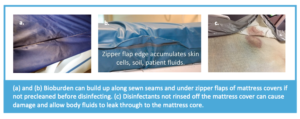
No. Research shows that 1-step processes achieve less than a 90% reduction in harmful bacteria on mattresses.38 Using the broadest interpretation, the FDA recommends that mattress reprocessing achieves at least a 99.9999% reduction in vegetative bacteria.23,24 A 1-step process can also leave residual chemicals on the mattress surface, a concern for patient safety.39 Additionally, 1-step processes can cause premature damage to your mattresses, which may void your warranty and expose patients to additional risk.17,18 Not only this, but a 1-step process of simply wiping the mattress with a disinfectant falls well short of the processes recommended by manufacturers, which usually involve 5-6 steps. This includes pre-cleaning visible soil, cleaning non-visible soil, rinsing off the cleaning agent, disinfecting with an approved disinfectant, rinsing off the disinfectant, allowing the mattress to dry, and visually inspecting the mattress for damage.40-42
FOLLOW-UP: Perform a mattress audit at your facility to determine if any of your mattresses have been compromised. The FDA recommends removing any damaged, worn, or visibly stained mattresses according to facility procedures and MIFUs and replacing mattress covers that have visible signs of stains, damage, or wear.16 The bed deck should be checked for rust as well
